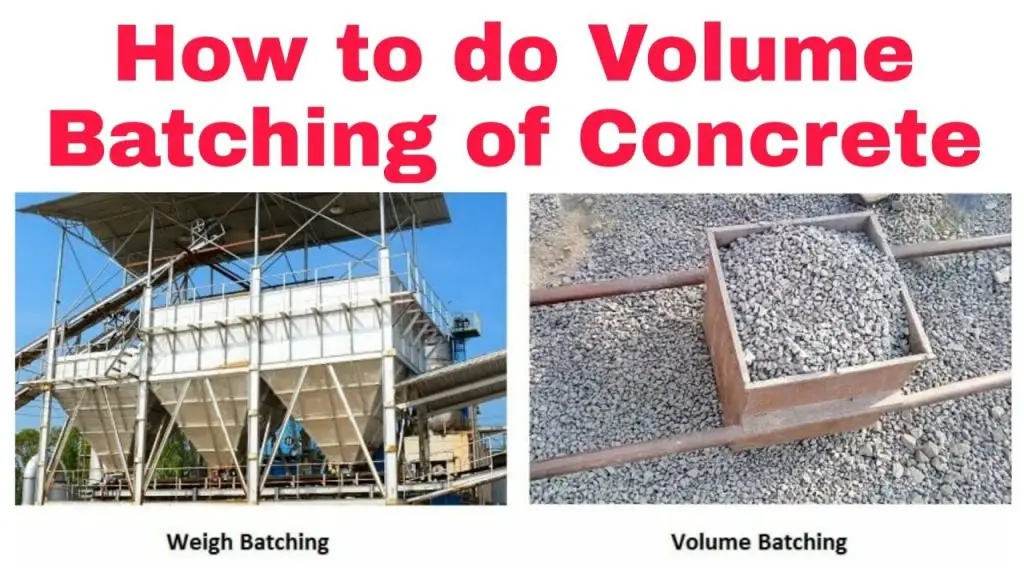Batching of Concrete | Weigh Batching | Volume Batching of Concrete
Batching of Concrete | Weigh Batching | Volume Batching of Concrete
What is Batching of Concrete?
Batching is a process of measuring the ingredients in batches for mixing and is done either by weight or by volume. Volume batching is based on nominal mix and weight batching is based on design mix.
The two common methods of batching are
- Volumetric batching as in case of nominal mixing
- Weight batching in case of design mixing
For all important concrete work batching should be done by weight and mixing by machine mixers. For very small projects where mixing is performed on the site, the materials are usually batch to volume.
Volume Batching
Usually, it has done through one bag mixer machines, and under these conditions, accurate proportioning is very difficult. To achieve a reasonable minimum quality of concrete, it is usually less expensive to prescribe an excess of cement than to employ quality control.
In volume batching the ingredients are batch and proportion based on volume. It is achieved by using a constructed gauge boxes called Farmass.
For proportioning cement is measured by bags and water in litres. The quality of concrete may differ because of the bulkage of fine aggregate, and therefore concrete may not be uniforms and consistent.
Volume batching is performed using gauged boxes of inside dimensions of 350 millimeters by 400 millimeters by 250 millimeters. The box volume is 0.35 cubic meters, equivalent to the volume of one bag of cement.
The nominal mix, which is 1:2:4, use one bag of cement, two boxes of sand, and four coarse aggregate boxes and mix them together.
Weigh Batching
In weight batching the ingredients are patched based on the weight of individual components. A wide variety of equipment performs the mixing.
Water for mixing is weighed out precisely as a function of the weight of cement used for each mixed proportion hence uninformed water-cement ratio is maintained.
Each batch is weighted, making it easy to detect overrun or incorrect dosages concrete with uniform and consistent quality.
Grading of coarse aggregates and fine aggregate shall be checked out at frequent intervals to ensure that grading meets mixed design requirements. The amount of added water shall be adjusted to compensate for any variations in moisture content in aggregates.
No substitution of materials or change in the established mixed proportions shall be permitted. Volume batching may be allowed only where weight batching is not practical.
The Weight Batching Process.
Cement weight:
The cement pins or silos should be large enough to cope with all types of concrete mixes. Bins should have steep angle walls so that cement does stick to the surfaces.
For manual loading of cement, load cell weigh where individual bends in which cement is emptied.
For batching plants, screw conveyors transport cement to the mixing drum.
Water batching.
The plants are equipped with a water batch wade or a water meter as the water content is a key component to the concrete mix’s strength. Ensure proper functioning of the water measuring devices. In automated plants, the microprocessor adjusts the quantity of water present on the surface of the aggregate.
Aggregate Weighing Batching
In aggregate weight batching, in three bag mixer machines, load cells and aggregates are added manually in the bins. In concrete batching plant aggregates from Pin are unloaded automatically into the weigher below through a batch in the gate. The required amount is then conveyed to the concrete mixer.
Mixing Arrangement.
The concrete production plant uses to type of mixing arrangement, namely:
- Batch mixers.
- Continuous mixer.
Batch Mixers
It produces one batch at a time. They use freefall, the methodology of mixing components. There are two types of concrete batch mixers distinguished by the axis of rotation of the drum:
- Horizontal drum mixers or
- Vertical the pan mixers.
Horizontal drum mixers
Horizontal mixers also called drum mixers. The drum mixers have a drum with fixed blades rotating around its axis. Type of horizontal mixers area:
- Reversing drum as self-loading mixers,( Ajax) and three bag mixer machines
- Tilting drum as in one bag mixer machines.
- Non-tilting drum in which mixes the materials, are added at one end and discharged at the other.
Pan Mixers
The pan mixers may have either the blades or the band rotating around the axis. In the concrete batching plant, three ingredients mixed by the mixer’s moving arms give better homogeneity and consistency.
Continuous mixers.
These are power mixers, as in batching plants. The concrete components continuously enter at one end as the fresh concrete exits the other end.
The materials are continuously fed into the mixer. Upon mixing, the concrete is discharged from the other end. They usually have screw-type blades, rotating in the middle of the drum.
Weight Batching versus Volume Batching.
Weigh Batching
- Ingredients are batch or proportion based on weight.
- Use of weight batching
- Quality is uniform and consistent.
- In this method, this method is costlier.
- However, this method is more precise.
Volume Concrete Batching.
- Method ingredients are batch or proportion based on volume.
- By using a measuring box or, say (farmass),
- Can experience variations in quality due to inconsistent mixing.
- This method is cheaper and less precise.
Loading Period.
The mixing time is defined as the time elapsed between the first constituent’s loading to the final discharge of the concrete.
The loading method includes loading the constituents into the mixer and the duration of the loading period.
The loading period divides into two parts.
Dry Mixing and Wet Mixing
This period’s duration depends on how long the constituents are mixed dry before the addition of water and how fast the constituents are loaded.
Loading phase
Dry mixing is the mixing that occurs during loading, but before water is introduced.
Wet mixing is the mixing after oil while water is being introduced but still during loading.
Loading Sequencing.
The loading period is important because some of the concrete properties will depend on the order in which the constituents are introduced in the mixer.
Later addition of water and admixtures helps the better spreading of the cement among aggregate.
Wear and Tear of Mixers
In determining mixer efficiency, the main focus should also be on getting homogeneous concrete.
Usage of mixer leads to the wear of the blades on the buildup of cement-based or mortar. This will lead to improper mixing.
The concrete mixer should be thoroughly cleaned at the end of each day of operation, and the blades and or scraper changed on a regular schedule.
Summary of Concrete Batching
Concrete mixing is a complicated process that is affected by the type of mixer, the mixing cycle, and the loading methods. Also, a lot of electrical energy is consumed in the mixing cycle. Ensure proper mixing is done to produce high-quality concrete.



